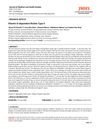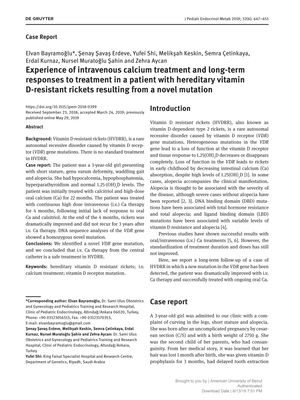TLDR Intravenous calcium therapy is a safe and effective treatment for a rare type of rickets.
In a case report of a 3-year-old girl with hereditary vitamin D-resistant rickets (HVDRR) due to a novel mutation in the vitamin D receptor (VDR) gene, the patient exhibited symptoms such as short stature, genu varum deformity, waddling gait, and alopecia, along with hypocalcemia, hypophosphatemia, and hyperparathyroidism. Despite 22 months of treatment with calcitriol and high-dose oral calcium, there was no response, leading to a switch to continuous high-dose intravenous (i.v.) calcium therapy for 4 months. This treatment resulted in dramatic improvement in rickets, which did not recur for 3 years post-therapy. The study concluded that i.v. calcium therapy via a central catheter is a safe and effective treatment for HVDRR.
8 citations
,
December 2016 in “Hormone Research in Paediatrics” Tunisian children with hereditary vitamin D-resistant rickets showed improvement with calcium treatment, and new genetic mutations were identified.
109 citations
,
June 2011 in “Molecular and Cellular Endocrinology” Vitamin D receptor mutations can cause alopecia by affecting hair growth genes.
151 citations
,
June 2010 in “Endocrinology and metabolism clinics of North America” Two rare genetic diseases cause severe rickets in children due to defects in vitamin D metabolism.
50 citations
,
September 2009 in “Molecular Genetics and Metabolism” A new gene mutation causes vitamin D resistance and rickets, treatable with calcium therapy.
50 citations
,
September 2009 in “Molecular Genetics and Metabolism” A new gene mutation causes vitamin D resistance and rickets, treatable with calcium therapy.
107 citations
,
March 2014 in “BoneKEy Reports” Mutations in the vitamin D receptor cause hereditary vitamin D-resistant rickets, leading to poor bone health and requiring high calcium doses for treatment.
 July 2023 in “Journal of medical and health studies”
July 2023 in “Journal of medical and health studies” A 3-year-old with vitamin D-resistant rickets and severe hair loss died despite treatment, highlighting the need for improved management of the condition.
109 citations
,
June 2011 in “Molecular and Cellular Endocrinology” Vitamin D receptor mutations can cause alopecia by affecting hair growth genes.
151 citations
,
June 2010 in “Endocrinology and metabolism clinics of North America” Two rare genetic diseases cause severe rickets in children due to defects in vitamin D metabolism.

